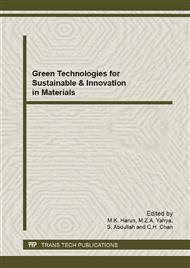[1]
Williams, D.F., Definitions in biomaterials : proceedings of a consensus conference of the European Society for Biomaterials, Chester, England, March 3-5, 1986 / edited by D.F. Williams. Progress in biomedical engineering ; 4, ed. D.F. Williams and B. European Society for1987, Amsterdam ; New York : Elsevier.
Google Scholar
[2]
Bayne, S.C., Dental Biomaterials: Where Are We and Where Are We Going? Journal of dental education 2005. 69(5): pp.571-585.
DOI: 10.1002/j.0022-0337.2005.69.5.tb03943.x
Google Scholar
[3]
Maria, V. -R., Evolution of bioceramics within the field of biomaterials. Comptes Rendus Chimie, 2010. 13(1): pp.174-185.
DOI: 10.1016/j.crci.2009.03.004
Google Scholar
[4]
LeGeros, R.Z., G. Daculsi, and J.P. LeGeros, Bioactive Bioceramics Musculoskeletal Tissue Regeneration, W.S. Pietrzak, Editor 2008, Humana Press. pp.153-181.
DOI: 10.1007/978-1-59745-239-7_8
Google Scholar
[5]
Curran, D., T. Fleming, M. Towler & S. Hampshire 2010. Mechanical properties of hydroxyapatite–zirconia compacts sintered by two different sintering methods. Journal of Materials Science: Materials in Medicine 21(4): 1109-1120.
DOI: 10.1007/s10856-009-3974-z
Google Scholar
[6]
Evis, Z., M. Usta, and I. Kutbay, Hydroxyapatite and zirconia composites: Effect of MgO and MgF2 on the stability of phases and sinterability. Materials Chemistry and Physics, 2008. 110(1): pp.68-75.
DOI: 10.1016/j.matchemphys.2008.01.009
Google Scholar
[7]
Manicone, P.F., P.R. Iommetti, and L. Raffaelli, An overview of zirconia ceramics: Basic properties and clinical applications. Journal of Dentistry, 2007. 35(11): pp.819-826.
DOI: 10.1016/j.jdent.2007.07.008
Google Scholar
[8]
Denry, I. and J.R. Kelly, State of the art of zirconia for dental applications. Dental Materials, 2008. 24(3): pp.299-307.
DOI: 10.1016/j.dental.2007.05.007
Google Scholar
[9]
Huang, X. and X. Miao, Novel porous hydroxyapatite prepared by combing H2O2 foaming with PU sponge and modified with PLGA and bioactive glass. Journal of Biomaterials Applications, 2007. 21(4): pp.351-374.
DOI: 10.1177/0885328206063905
Google Scholar
[10]
Dey, A., A. Mukhopadhyay, S. Gangadharan, M. Sinha & D. Basu 2009. Characterization of Microplasma Sprayed Hydroxyapatite Coating. Journal of Thermal Spray Technology 18(4): 578-592.
DOI: 10.1007/s11666-009-9386-2
Google Scholar
[11]
Hsu, F. -Y., S. -W. Tsai, C. -W. Lan & Y. -J. Wang 2005. An in vivo study of a bone grafting material consisting of hydroxyapatite and reconstituted collagen. Journal of Materials Science: Materials in Medicine 16(4): 341-345.
DOI: 10.1007/s10856-005-0633-x
Google Scholar
[12]
Askeland, D.R., P.P. Fulay, and W.J. Wright, The Science and Engineering of Materials2006: Cengage Learning.
Google Scholar
[13]
Sergey V, D., Bioceramics of calcium orthophosphates. Biomaterials, 2010. 31(7): pp.1465-1485.
Google Scholar
[14]
Sung, Y. -M., Y. -K. Shin, and J. -J. Ryu, Preparation of hydroxyapatite/zirconia bioceramic nanocomposites for orthopaedic and dental prosthesis applications. Nanotechnology, 2007. 18(6): 065602(6pp).
DOI: 10.1088/0957-4484/18/6/065602
Google Scholar
[15]
Yang, C., Y. -k. Guo, and M. -l. Zhang, Thermal decomposition and mechanical properties of hydroxyapatite ceramic. Transactions of Nonferrous Metals Society of China, 2010. 20(2): pp.254-258.
DOI: 10.1016/s1003-6326(09)60131-x
Google Scholar
[16]
Rapacz-Kmita, A., A. Slosarczyk, Z. Paszkiewicz & C. Paluszkiewicz 2004. Phase stability of hydroxyapatite-zirconia (HAp/ZrO2) composites for bone replacement. Journal of Molecular Structure 704(1-3): 333-340.
DOI: 10.1016/j.molstruc.2004.02.047
Google Scholar
[17]
Towler, M.R. and I.R. Gibson, The effect of low levels of zirconia addition on the mechanical properties of hydroxyapatite. Journal of Materials Science Letters, 2001. 20(18): pp.1719-1722.
Google Scholar
[18]
Ramachandra Rao, R. and T.S. Kannan, Synthesis and sintering of hydroxyapatite-zirconia composites. Materials Science and Engineering: C, 2002. 20(1-2): pp.187-193.
DOI: 10.1016/s0928-4931(02)00031-0
Google Scholar
[19]
Evis, Z., Reactions in hydroxylapatite-zirconia composites. Ceramics International, 2007. 33(6): pp.987-991.
DOI: 10.1016/j.ceramint.2006.02.012
Google Scholar
[20]
Li, J., H. Liao, and L. Hermansson, Sintering of partially-stabilized zirconia and partially-stabilized zirconia-hydroxyapatite composites by hot isostatic pressing and pressureless sintering. Biomaterials, 1996. 17(18): pp.1787-1790.
DOI: 10.1016/0142-9612(95)00356-8
Google Scholar
[21]
Celaletdin, E., Enhanced phase stability in hydroxylapatite/zirconia composites with hot isostatic pressing. Ceramics International, 2011. 37(3): pp.935-942.
DOI: 10.1016/j.ceramint.2010.11.001
Google Scholar


